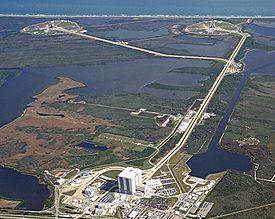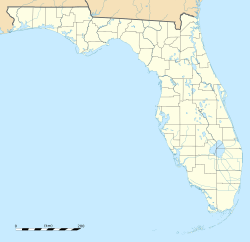Crawlerway facts for kids
Quick facts for kids |
|
|
Crawlerway
|
|

Aerial view of Launch Complex 39. The Crawlerway is the pathway between the Vehicle Assembly Building and Pads 39A and 39B.
|
|
| Location | Brevard County, Florida |
|---|---|
| Nearest city | Merritt Island |
| Built | 1964 |
| MPS | John F. Kennedy Space Center MPS |
| NRHP reference No. | 99001641 |
| Added to NRHP | January 21, 2000 |
The Crawlerway is a special road at the Kennedy Space Center in Florida. It is about 130-foot-wide (40 m), which is like having two huge lanes side-by-side. This pathway connects the Vehicle Assembly Building (VAB) to the two main launch pads, Pad 39A and Pad 39B.
The Crawlerway is very long. It stretches for about 3.4 miles (5.5 km) to Pad 39A and 4.2 miles (6.8 km) to Pad 39B. It was built to be incredibly strong. Underneath its surface, there is a seven-foot (2 m) deep bed of stones. On top of that is a layer of asphalt, and then a surface made of special rocks from the Alabama River.
This super-strong road was first made for the Apollo program. It had to hold the massive weight of the Saturn V rocket. This included the rocket itself, its payload, the Launch Umbilical Tower, and the mobile launcher platform. All of this was carried by a huge machine called a crawler-transporter. Later, from 1981 to 2011, the Crawlerway was also used to move the lighter Space Shuttles to their launch pads.
Building the Crawlerway helped connect Merritt Island to the mainland. This made Merritt Island into a peninsula. The main road for vehicles going to the launch pads, called the Saturn Causeway, runs right next to the Crawlerway.
Building the Crawlerway
The Crawlerway is made of two lanes, each about 40-foot-wide (12 m). A 50-foot (15 m) wide area separates these two lanes. The very top layer is made of Alabama river rock. This rock layer is about 4 inches (10 cm) thick on straight parts of the road. On curves, it's thicker, about 8 inches (20 cm) thick.
Alabama river rock was chosen because it is very hard and round. It also resists wear and tear. Below this top layer, there is 4 feet (1.2 m) of crushed stone. Underneath that are two more layers of fill material.
In 2013, the Crawlerway needed some repairs and upgrades. This was the first time its deep foundation had been fixed since it was built. More rock was added to the surface in June 2014 to keep it strong.
Gallery
-
The prototype Space Shuttle Enterprise on the Crawlerway in July 1979.
-
The Space Shuttle Atlantis moving back to the VAB in January 2001.








